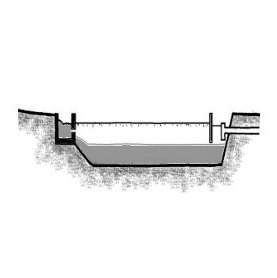المُلخص التنفيذي
Sedimentation or thickening ponds are settling ponds that allow faecal sludge to thicken and dewater. The effluent is removed and treated, while the thickened sludge can be further treated in a subsequent technology (e.g. in waste stabilisation ponds, planted or unplanted drying beds, short rotation plantations or by composting) . The ponds are designed as simple ponds in which faecal sludge is filled and solids settle to the ground. Fresh sludge (e.g. from latrines or unsewered public toilets) will require long retention times during which settled sludge will undergo further stabilisation by anaerobic digestion. Partially digested sludge with little organic matter and easily settable solids (e.g. from septic tanks, anaerobic digesters etc.) will require retention times of some hours only and settled sludge is desludged and transferred to the next tratment step more frequently. Short-retention-time thickening ponds are often called settling tanks, while long-retention and stabilisation-thickening ponds are called sedimentation or anaerobic ponds.
| المُدخلات | المُخرَجات |
|---|---|
Compost (for further off-site composting), Soil, Treated Water, Fertigation Water or Water requiering further treatment |
Introduction
Faecal sludge is not a uniform product and, therefore, its treatment must be specific to the characteristics of the specific sludge. Generally, such sludge does not have a higher solids content than 2 to 10 % (SASSE & BORDA 1998). Sludge, which is still rich in organics and has not undergone significant degradation, is difficult to dewater. Conversely, sludge that has undergone significant anaerobic degradation, is more easily dewatered.
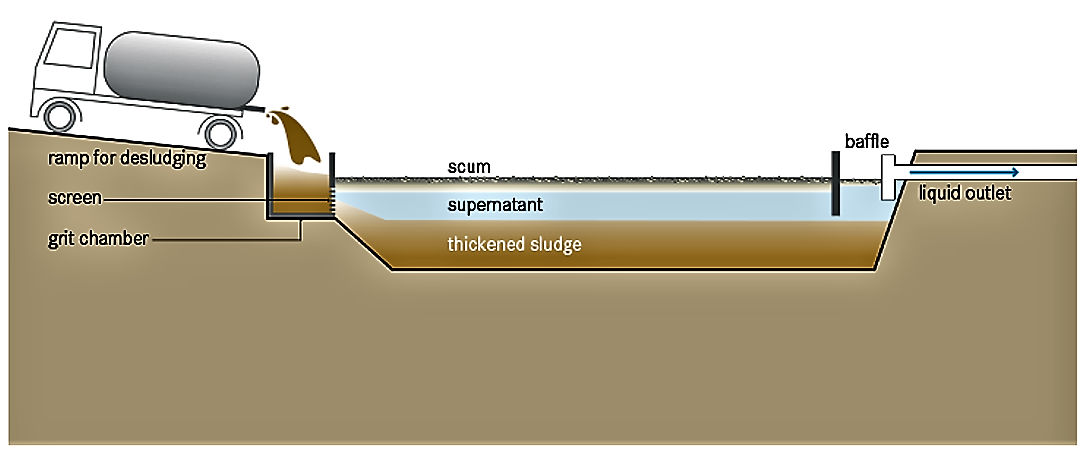
In order to be properly dried, fresh sludge rich in organic matter ( high-strength sludge (HEINSS et al. 1998) e.g., latrine or public toilet sludge) must first be stabilized. Allowing the sludge to degrade anaerobically in sedimentation / thickening ponds which provide a long hydraulic retention time of several days or a few weeks can do this (STRAUSS & MONTANGERO 2002) . The same type of pond can be used to thicken sludge which is already partially stabilized ( low-strength sludge (HEINSS et al. 1998) e.g., originating from Septic Tanks , anaerobic digesters, biogas settlers, trickling filters or activated sludge processes , etc.), although it undergoes less degradation and requires more time to settle. The degradation process may actually hinder the settling of sludge because the gases produced bubble up and re-suspend the solids.
The ponds may be differentiated in thickening ponds for the treatment of fresh sludge (high-strength sludge, settling tanks) and thickening ponds for the treatment of low-strength sludge (sedimentation ponds).
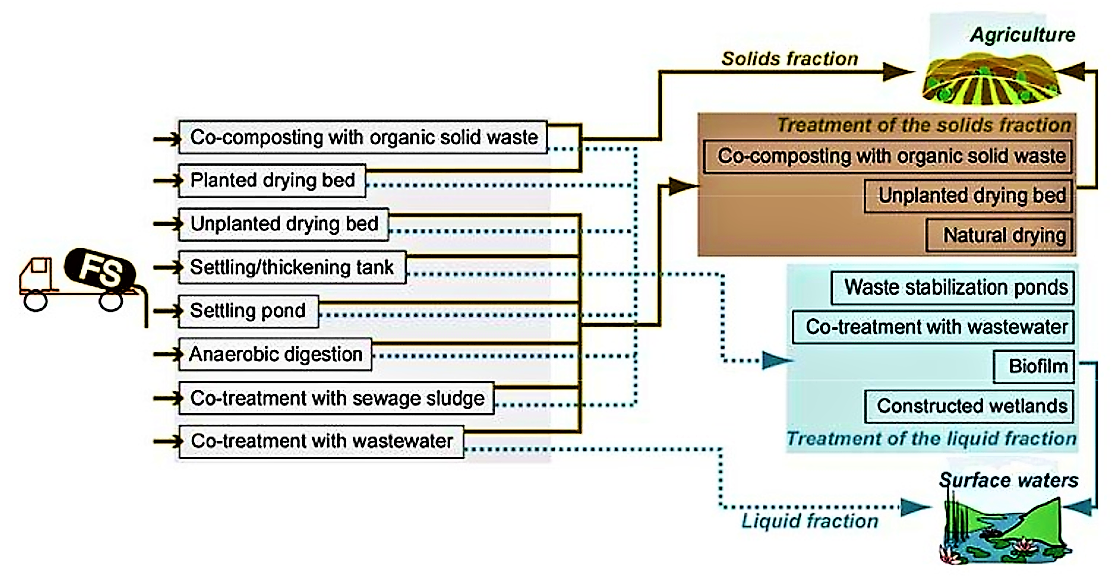
As the sludge settles and digests, the supernatant must be decanted and treated separately. Appropriate post-treatment may be waste stabilisation ponds (optionally together with other wastewater) or soil infiltration (e.g. in soak pits, or leach fields) depending on the degree of pollution. The thickened sludge occupies much less volume and can be more easily transported. However, it can still contain pathogens and needs to be further treated. The thickened sludge can then be dried or further composted before reuse, disposal or incineration. Typically, sludge from thickening ponds is transformed into biosolids on drying beds or co-composted together with organic solid waste (co-composting small or large-scale). In some cases, it may also be spread out in thin layers on the ground .
Design Considerations[no-ecompendium]
Two tanks operating in parallel are required; one can be operated, while the other is emptied. Both sedimentation ponds and settling tanks are designed based on the storage volume required for a desired depth and quantity of accumulating solids (STRAUSS & MONTANGERO 2002) in a given time (depending on the frequency of desludging). The specific volume occupied by separated solids may vary from 0.02 (thin sludge) up to 0.15 (high-strength sludge) m3/m3 of raw sludge depending on the type and composition and on the time allowed for solids consolidation and thickening (HEINSS et al. 1998; STRAUSS & MONTANGERO 2002). To achieve maximum efficiency, loading and resting periods should not exceed 4 to 5 weeks, although much longer cycles are common. When a 4-week loading and 4-week resting cycle is used, total solids (TS) can be increased to 14% (depending on the initial concentration).
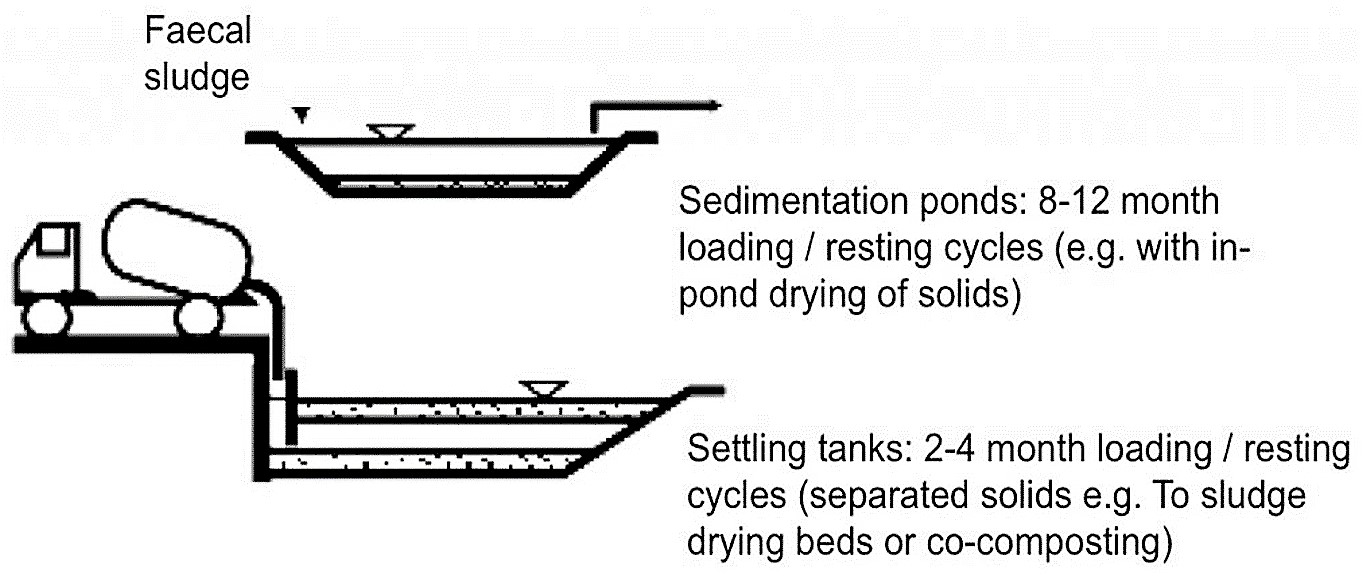
Sedimentation Ponds
Sedimentation ponds are designed similar to anaerobic ponds in waste stabilisation ponds with a sufficient volume for sludge accumulation over a long period (KLINGEL et al. 2002). The anaerobic digestion process, which stabilises the fresh sludge, causes gas production (MONTANGERO & STRAUSS 2004). When the gas bubbles rise, this can further limit the sludge settling as solids are also pushed to the surface, but the produced biogas can be collected and used for heating or cooking (i.e. by covering the pond with a gastight canvas). Sedimentation ponds can be operated in batch and continuous mode and sludge is removed only once every 8 to 12 month (STRAUSS & MONTANGENRO 2002). Therefore they require generally more space than simple settling ponds. The organic load of sedimentation or anaerobic ponds vary from 250 to 350 gBOD/m3 per day and the volume of accumulated sludge per incoming solids may vary between 0.8 to 2 L/Kg TS (KLINGEL et al. 2002).
Settling Tanks
Settling tanks need not only sufficient volume for sludge accumulation, but also sufficient depth of the liquid column (> 1.5 m) in order to allow a fast and good settling (KLINGEL et al. 2002). The loading/resting cycle in settling tanks is much shorter than in sedimentation ponds and sludge is removed about every 2 to 4 months (STRAUSS & MONTANGERO 2002). The tanks should be equipped with baffles to maintain hydraulic conditions favourable to good settling and to retain floating scum (KLINGEL et al. 2002).
For design, accumulating sludge volumes per incoming solids load of 5 to 9 L/kg TS can be considered. However, the consistency and concentration of faecal sludge is highly variable (depending on storage duration, tank emptying technology and pattern, performance of treatment of collection unit, added matters, temperature, intrusion of ground- or surface waters, etc. (MONTANGERO & STRAUSS 2004) and treatment systems should be designed on a case-to-case basis (EAWAG/SANDEC 2008).
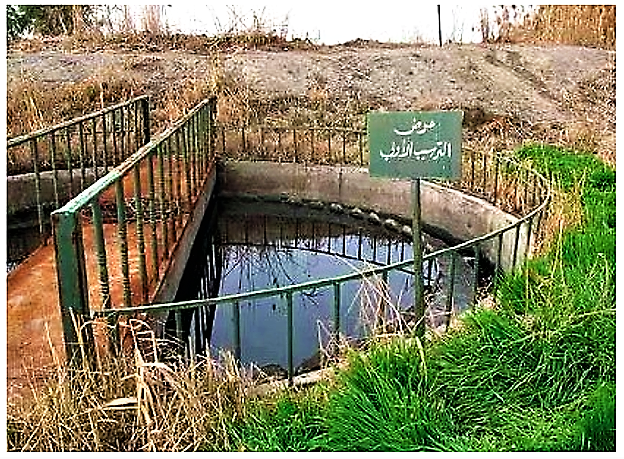
Whether a sedimentation pond or a settling tank is used depends on the consistency of the sludge (e.g. fresh vs. old sludge), the space available and the means of sludge removal.
When only little space is available, fresh toilet sludge may be diluted with more stabilised sludge in order to be treatable in settling tanks (KLINGEL et al. 2002). It is also important to consider that the quantities of solids, which are produced and have to be removed in settling ponds, are much smaller than the mass of solid to be removed and handled from sedimentation ponds (EAWAG/SANDEC 2008). But frequent sludge removal can also become expensive for operators.
The removal rates, which may be expected in sedimentation ponds and settling tanks are (STRAUSS & MONTANGERO 2002):
|
| Sedimentation Pond | Settling Tank |
| Suspended Solids | 60 % | > 95 % |
| BOD and COD (unfiltered) | 30 to 50 % | 70 to 95 % |
| BOD (filtered) | 18 % | 45 % |
Health Aspects/Acceptance
Both the incoming and thickened sludge are pathogenic; therefore, workers should be equipped with proper protection (boots, gloves, and clothing). The supernatant liquid can be polluted with microbes as well and needs to be correctly treated or infiltrated. The thickened sludge is not sanitized and requires further treatment before disposal. Ideally, this technology should be coupled with a subsequent treatment technology if a hygienic product is required.
The ponds may cause a nuisance for nearby residents due to bad odours and the presence of flies. Thus, they should be located sufficiently away from residential areas.
Costs Considerations
Pond systems are relatively low cost, as they do not require much maintenance and no energy. However, large surface areas must be available and they need to be designed and operated by skilled staff. Depending on the frequency of desludging, emptying may become expensive or labour intensive.
Operation and Maintenance
Maintenance is an important aspect of well-functioning ponds, but it is not intensive. The discharging area must be maintained and kept clean to reduce the potential of disease transmission and nuisance (flies and odours). Solid waste that is discharged along with the sludge must be removed from the screen at the inlet of the ponds.
The thickened sludge must be mechanically removed (with a front end loader or other specialized equipment) after it has sufficiently thickened every 8 to 12 or 2 to 4 months for sedimentation ponds or settling tanks respectively (STRAUSS & MONTANGERO 2002) .
Trained staff for operation and maintenance is required to ensure proper functioning (TILLEY et al. 2008).
At a Glance
| Working Principle | Thickening ponds are simple ponds designed for the solid-liquid separation of faecal sludge. There are two types of thickening ponds: Sedimentation ponds, which require long retention times and hence also allow for anaerobic degradation (similar to anaerobic ponds in WSP); and settling ponds as a primary treatment of already partly digested sludge (e.g. from septic tanks or anaerobic digesters) providing only short retention times. |
| Capacity/Adequacy | Centralised; Requires large land-surfaces and can cause odour (should be installed far from communities); Is suited for almost any hot or temperate climate. |
| Performance | Depends strongly on the local climate (rain, runoff); Suspended solids can be removed up to 60 % (sedimentation pond, fresh sludge) and 95%, respectively (in settling tanks) from the supernatant and concentrated in the thickened sludge. Sludge and effluent are generally still pathogenic and need further treatment before being disposed or reused in agriculture. |
| Costs | Moderate investment costs and low operation costs. |
| Self-help Compatibility | Can be constructed with locally available material, but requires expert design and skilled operation. |
| O&M | Application of sludge, desludging, cleaning of surrounding and incoming sludge from solid wastes. Desludging every 2 to 4 or 8 to 12 months for settling tanks or sedimentation ponds respectively. |
| Reliability | High, if the area is kept dry and hot or temperate |
| Main strength | Low-tech and no requirement of energy. |
| Main weakness | Requires space and desludging as well as further treatment of both liquids and solids. |
Sedimentation ponds can be used for partly stabilised faecal sludge such as sludge from septic tanks, anaerobic baffled reactors, large or small scale anaerobic digesters, biogas settlers, etc. They are not suited for fresh faecal sludge. Settling tanks can be used as first step in fresh faecal sludge treatment (e.g. from latrines or unsewered public toilets). Often, they are the first stage in a sequence of stabilisation ponds (see also anaerobic ponds in waste stabilisation ponds).
Sedimentation/thickening ponds are appropriate where there is inexpensive, available space located far from homes and businesses; it should be established at the border of the community. The thickened sludge is still infectious, although it is easier to handle and less prone to splashing and spraying. It needs further treatment before reuse or disposal (drying, composting). The supernatant liquid needs to be infiltrated or further treated (e.g. in waste stabilisation ponds) depending on the pollution/pathogen removal performance of the thickening ponds.
Trained staff for operation and maintenance is required to ensure proper functioning.
This is a low-cost option that can be installed in most hot and temperate climates. Excessive rain may prevent the sludge from properly settling and thickening.
Faecal Sludge Management. Pdf Presentation
A presentation about faecal sludge management in developing countries.
EAWAG ; SANDEC (2008): Faecal Sludge Management. Pdf Presentation. (= Sandec Training Tool 1.0, Module 5 ). Duebendorf: Swiss Federal Institute of Aquatic Science (Eawag), Department of Water and Sanitation in Developing Countries (Sandec) URL [Accessed: 23.05.2012]Faecal Sludge Management. Lecture Notes
This module pays special attention to the haulage, treatment and reuse or disposal of faecal sludge. It covers both technical and non-technical (socio-cultural, economic, political etc.) aspects and provides practical information on design, financing and planning of faecal sludge treatment plants.
EAWAG/SANDEC (2008): Faecal Sludge Management. Lecture Notes. (= Sandec Training Tool 1.0, Module 5 ). Duebendorf: Swiss Federal Institute of Aquatic Science (EAWAG), Department of Water and Sanitation in Developing Countries (SANDEC) URL [Accessed: 23.05.2012]Solids Separation and Pond Systems for the Treatment of Faecal Sludges in the Tropics
The report sets out to provide guidelines for the preliminary design of faecal sludge treatment schemes comprising solids-liquid separation and stabilisation ponds. The document is based on the results of collaborative field research conducted by the Ghana Water Research Institute and SANDEC on full and pilot-scale faecal sludge (FS) treatment plants located in Accra, Ghana.
HEINSS, U. LARMIE, S.A. STRAUSS, M. (1998): Solids Separation and Pond Systems for the Treatment of Faecal Sludges in the Tropics . Lessons Learnt and Recommendations for Preliminary Design . (= SANDEC Report , 5 ). Duebendorf: Swiss Federal Institute of Aquatic Science (EAWAG), Department of Water and Sanitation in Developing Countries (SANDEC) URL [Accessed: 12.04.2010]SOS - Management of Sludges from On-Site Sanitation. Characteristics of Faecal Sludges and their Solids-Liquid Separation
This document gives an overview on the characteristics of different sludges as well as monitoring results and recommendations for design of solid-liquid separation. It is based on a field report.
HEINSS, U. LARMIE, S.A. STRAUSS, M. (1999): SOS - Management of Sludges from On-Site Sanitation. Characteristics of Faecal Sludges and their Solids-Liquid Separation. Duebendorf and Accra: Swiss Federal Institute of Aquatic Science (EAWAG)Fecal Sludge Management in Developing Countries - A Planning Manual
This manual is a first approach to provide guidance on strategic planning of faecal sludge management. The study took place in the City of Nam Dinh, in Vietnam. The main principles for strategic sanitation planning have been adopted from the guide “Strategic Planning for Municipal Planning” from GHK Research and Training Ltd.
KLINGEL, F. MONTANGERO, A. KONE, M. STRAUSS, M. (2002): Fecal Sludge Management in Developing Countries - A Planning Manual. (= First Edition ). Duebendorf: Swiss Federal Institute for Environmental Science (EAWAG) URL [Accessed: 08.06.2019]Effluent reuse from constructed wetland system Haran Al-Awamied, Syria
In the village of Haran Al-Awamied a gravity sewer system already existed and waste water was collected for irrigation without any treatment. GTZ and MHC (Syrian Ministry of Housing and Construction) initiated a project for a new ecological treatment plant (settling tank and a vertical flow CW).
MOHAMED, A. KLINGEL, F. BRACKEN, P. WERNER, C. (2009): Effluent reuse from constructed wetland system Haran Al-Awamied, Syria. (= SuSanA - Case Studies ). Eschborn: Sustainable Sanitation Alliance (SuSanA) URL [Accessed: 26.01.2011]Faecal Sludge Treatment
This document reviews current practices of faecal sludge management and treatment.
MONTANGERO, A. STRAUSS, M. (2004): Faecal Sludge Treatment. Duebendorf: Swiss Federal Institute of Aquatic Science (EAWAG), Department of Water and Sanitation in Developing Countries (SANDEC) URL [Accessed: 10.06.2019]DEWATS
Exhaustive report on technological, operational and economic aspects of decentralised waste water treatment systems. Spreadsheet examples support the reader in designing and planning waste water treatment systems components.
SASSE, L. BORDA (1998): DEWATS. Decentralised Wastewater Treatment in Developing Countries. Bremen: Bremen Overseas Research and Development Association (BORDA) URL [Accessed: 03.06.2019]Faecal Sludge Management
This is the first book to compile the current state of knowledge on faecal sludge management. It addresses the organization of the entire faecal sludge management service chain, from the collection and transport of sludge, to the current state of knowledge of treatment options, and the final end use or disposal of treated sludge. It presents an integrated approach that brings together technology, management, and planning, based on Sandec’s 20 years of experience in the field. It also discusses important factors to consider when evaluating and upscaling new treatment technology options. The book is designed for undergraduate and graduate students, engineers, and practitioners in the field who have some basic knowledge of environmental and/or wastewater engineering.
STRANDE, L. ; RONTELTAP, M. ; BRDJANOVIC, D. (2014): Faecal Sludge Management. Systems Approach for Implementation and Operation. London: IWA Publishing URL [Accessed: 16.07.2014]Urban Excreta Management - Situation, Challenges, and Promising Solutions
The objective of this paper is to render planners, decision makers, and consultants aware that faecal sludge management (FSM) should form an integral part of the urban development planning process. For this, three illustrative cases are presented, based on which an array of measures or tools, as well as institutional/regulatory, financial/economic, and technical aspects are discussed.
STRAUSS, M. ; BARREIRO, W.C. ; STEINER, M. ; MENSAH, A. ; JEULAND, M. ; BOLOMEY, S. ; MONTANGERO, A. ; KONE, D. (2003): Urban Excreta Management - Situation, Challenges, and Promising Solutions. المُدخلات: IWA Asia-Pacific Regional Conference Bangkok, Thailand: URL [Accessed: 23.06.2010]Co-composting of Faecal Sludge and Municipal Organic Waste
The document gives an overview on the combined composting of (faecal) sludges and organic solid waste based on a pilot project in Kumasi, Ghana. Results of the investigation should help the city’s waste management department to develop its biosolids management strategy and enable the project team to develop guidelines for planners and engineers on the option of co-composting.
STRAUSS, M. DRESCHER, S. ZURBRUEGG, C. MONTANGERO, A. OLUFUNKE, C. DRECHSEL, P. (2003): Co-composting of Faecal Sludge and Municipal Organic Waste. Swiss Federal Institute of Aquatic Science (EAWAG), Department of Water and Sanitation in Developing Countries (SANDEC) and International Water Management Institute (IWMI) URL [Accessed: 05.06.2019]FS Management – Review of Practices, Problems and Initiatives
A study on management and institutional aspects regarding the challenges and possible improvements in managing faecal sludge.
STRAUSS, M. MONTANGERO, A. (2002): FS Management – Review of Practices, Problems and Initiatives. London and Duebendorf: DFID Project R8056, Capacity Building for Effective Decentralised Wastewater Management, Swiss Federal Institute of Aquatic Science (EAWAG), Department of Water and Sanitation in Developing Countries (SANDEC) URL [Accessed: 28.05.2019]Compendium of Sanitation Systems and Technologies. 2nd Revised Edition
This compendium gives a systematic overview on different sanitation systems and technologies and describes a wide range of available low-cost sanitation technologies.
TILLEY, E., ULRICH L., LÜTHI, C., REYMOND P. and ZURBRÜGG C. (2014): Compendium of Sanitation Systems and Technologies. 2nd Revised Edition. Duebendorf, Switzerland: Swiss Federal Institute of Aquatic Science and Technology (Eawag) URL [Accessed: 03.05.2023] PDFCompendium of Sanitation Systems and Technologies
This compendium gives a systematic overview on different sanitation systems and technologies and describes a wide range of available low-cost sanitation technologies.
TILLEY, E., LUETHI, C., MOREL, A., ZURBRUEGG, C. and SCHERTENLEIB, R. (2008): Compendium of Sanitation Systems and Technologies. Duebendorf, Switzerland: Swiss Federal Institute of Aquatic Science and Technology (EAWAG) and Water Supply and Sanitation Collaborative Council (WSSCC) URL [Accessed: 15.02.2010] PDFEnvironmentally sound technologies in wastewater treatment for the implementation of the UNEP/GPA "Guidelines on Municipal Wastewater Management"
Technical information on environmentally sound technologies in wastewater treatment.
UNEP ; MURDOCH UNIVERSITY (2004): Environmentally sound technologies in wastewater treatment for the implementation of the UNEP/GPA "Guidelines on Municipal Wastewater Management". The Hague: United Nations Environment Programme Global Programme of Action (UNEP/GPA), Coordination OfficeCompendium of Sanitation Systems and Technologies (Arabic)
This is the Arabic version of the Compendium of Sanitation Systems and Technologies. The Compendium gives a systematic overview on different sanitation systems and technologies and describes a wide range of available low-cost sanitation technologies.
TILLEY, E. ULRICH, L. LUETHI, C. REYMOND, P. SCHERTENLEIB, R. ZURBRUEGG, C. (2014): Compendium of Sanitation Systems and Technologies (Arabic). 2nd Revised Edition. Duebendorf, Switzerland: Swiss Federal Institute of Aquatic Science and Technology (Eawag) PDFFaecal Sludge Management.
This issue presents studies from different regions (Bangladesh, Cameroon, Burkina Faso) that mainly show the non-existence of faecal sludge management. Additionally, the last paper describes a new technological solution (LaDePa) for producing hygienically safe organic fertiliser from sludge from ventilated improved pit toilets (VIPs).
ECOSAN CLUB (2012): Faecal Sludge Management.. (= Sustainable Sanitation Practice , 13 ). Vienna: Ecosan Club URL [Accessed: 16.10.2012]Solids Separation and Pond Systems for the Treatment of Faecal Sludges in the Tropics
The report sets out to provide guidelines for the preliminary design of faecal sludge treatment schemes comprising solids-liquid separation and stabilisation ponds. The document is based on the results of collaborative field research conducted by the Ghana Water Research Institute and SANDEC on full and pilot-scale faecal sludge (FS) treatment plants located in Accra, Ghana.
HEINSS, U. LARMIE, S.A. STRAUSS, M. (1998): Solids Separation and Pond Systems for the Treatment of Faecal Sludges in the Tropics . Lessons Learnt and Recommendations for Preliminary Design . (= SANDEC Report , 5 ). Duebendorf: Swiss Federal Institute of Aquatic Science (EAWAG), Department of Water and Sanitation in Developing Countries (SANDEC) URL [Accessed: 12.04.2010]Low-cost Options for Treating Faecal Sludges (FS) in Developing Countries - Challenges and Performance
This article analyses and discusses the performances of low-cost technology for treating faecal sludges in developing countries. It shows that where septic tanks are the predominant type of on-site sanitation installations, septage is the only or predominant type of faecal sludge generated. It also shows that constructed wetlands, settling tanks/ponds, or unplanted drying beds might prove suitable as a pre-treatment.
KONE, D. STRAUSS, M. (2004): Low-cost Options for Treating Faecal Sludges (FS) in Developing Countries - Challenges and Performance. Duebendorf: Water and Sanitation in Developing Countries (SANDEC), Swiss Federal Institute for Environmental Science (EAWAG) URL [Accessed: 23.06.2010]Faecal Sludge Treatment
This document reviews current practices of faecal sludge management and treatment.
MONTANGERO, A. STRAUSS, M. (2004): Faecal Sludge Treatment. Duebendorf: Swiss Federal Institute of Aquatic Science (EAWAG), Department of Water and Sanitation in Developing Countries (SANDEC) URL [Accessed: 10.06.2019]Co-composting of Faecal Sludge and Municipal Organic Waste
The document gives an overview on the combined composting of (faecal) sludges and organic solid waste based on a pilot project in Kumasi, Ghana. Results of the investigation should help the city’s waste management department to develop its biosolids management strategy and enable the project team to develop guidelines for planners and engineers on the option of co-composting.
STRAUSS, M. DRESCHER, S. ZURBRUEGG, C. MONTANGERO, A. OLUFUNKE, C. DRECHSEL, P. (2003): Co-composting of Faecal Sludge and Municipal Organic Waste. Swiss Federal Institute of Aquatic Science (EAWAG), Department of Water and Sanitation in Developing Countries (SANDEC) and International Water Management Institute (IWMI) URL [Accessed: 05.06.2019]Treatment of sludges from on-site sanitation — Low-cost options
Published in 1997, this article gives an overview on current literature-based knowledge regarding faecal sludge treatment along with results and conclusions from field research.
STRAUSS, M. ; LARMIE, S.A. ; HEINSS, U. (1997): Treatment of sludges from on-site sanitation — Low-cost options. المُدخلات: Water Science and Technology: Volume 6 , 129-136. URL [Accessed: 23.06.2010]Compendium of Sanitation Systems and Technologies
This compendium gives a systematic overview on different sanitation systems and technologies and describes a wide range of available low-cost sanitation technologies.
TILLEY, E., LUETHI, C., MOREL, A., ZURBRUEGG, C. and SCHERTENLEIB, R. (2008): Compendium of Sanitation Systems and Technologies. Duebendorf, Switzerland: Swiss Federal Institute of Aquatic Science and Technology (EAWAG) and Water Supply and Sanitation Collaborative Council (WSSCC) URL [Accessed: 15.02.2010] PDFSludge Treatment and Disposal
Sludge Treatment and Disposal is the sixth volume in the series Biological Wastewater Treatment. The book covers in a clear and informative way the sludge characteristics, production, treatment (thickening, dewatering, stabilisation, pathogens removal) and disposal (land application for agricultural purposes, sanitary landfills, landfarming and other methods). Environmental and public health issues are also fully described.
ANDREOLI, C.V. ; SPERLING, M. von ; FERNANDES, F. (2007): Sludge Treatment and Disposal. (= Biological Wastewater Treatment Series , 6 ). London: International Water Association (IWA) Publishing URL [Accessed: 27.05.2019]SOS - Management of Sludges from On-Site Sanitation. Characteristics of Faecal Sludges and their Solids-Liquid Separation
This document gives an overview on the characteristics of different sludges as well as monitoring results and recommendations for design of solid-liquid separation. It is based on a field report.
HEINSS, U. LARMIE, S.A. STRAUSS, M. (1999): SOS - Management of Sludges from On-Site Sanitation. Characteristics of Faecal Sludges and their Solids-Liquid Separation. Duebendorf and Accra: Swiss Federal Institute of Aquatic Science (EAWAG)Effluent reuse from constructed wetland system Haran Al-Awamied, Syria
In the village of Haran Al-Awamied a gravity sewer system already existed and waste water was collected for irrigation without any treatment. GTZ and MHC (Syrian Ministry of Housing and Construction) initiated a project for a new ecological treatment plant (settling tank and a vertical flow CW).
MOHAMED, A. KLINGEL, F. BRACKEN, P. WERNER, C. (2009): Effluent reuse from constructed wetland system Haran Al-Awamied, Syria. (= SuSanA - Case Studies ). Eschborn: Sustainable Sanitation Alliance (SuSanA) URL [Accessed: 26.01.2011]Faecal Sludge Management. Lecture Notes
This module pays special attention to the haulage, treatment and reuse or disposal of faecal sludge. It covers both technical and non-technical (socio-cultural, economic, political etc.) aspects and provides practical information on design, financing and planning of faecal sludge treatment plants.
EAWAG/SANDEC (2008): Faecal Sludge Management. Lecture Notes. (= Sandec Training Tool 1.0, Module 5 ). Duebendorf: Swiss Federal Institute of Aquatic Science (EAWAG), Department of Water and Sanitation in Developing Countries (SANDEC) URL [Accessed: 23.05.2012]Faecal Sludge Management. Pdf Presentation
A presentation about faecal sludge management in developing countries.
EAWAG ; SANDEC (2008): Faecal Sludge Management. Pdf Presentation. (= Sandec Training Tool 1.0, Module 5 ). Duebendorf: Swiss Federal Institute of Aquatic Science (Eawag), Department of Water and Sanitation in Developing Countries (Sandec) URL [Accessed: 23.05.2012]Fecal Sludge Management in Developing Countries - A Planning Manual
This manual is a first approach to provide guidance on strategic planning of faecal sludge management. The study took place in the City of Nam Dinh, in Vietnam. The main principles for strategic sanitation planning have been adopted from the guide “Strategic Planning for Municipal Planning” from GHK Research and Training Ltd.
KLINGEL, F. MONTANGERO, A. KONE, M. STRAUSS, M. (2002): Fecal Sludge Management in Developing Countries - A Planning Manual. (= First Edition ). Duebendorf: Swiss Federal Institute for Environmental Science (EAWAG) URL [Accessed: 08.06.2019]FS Management – Review of Practices, Problems and Initiatives
A study on management and institutional aspects regarding the challenges and possible improvements in managing faecal sludge.
STRAUSS, M. MONTANGERO, A. (2002): FS Management – Review of Practices, Problems and Initiatives. London and Duebendorf: DFID Project R8056, Capacity Building for Effective Decentralised Wastewater Management, Swiss Federal Institute of Aquatic Science (EAWAG), Department of Water and Sanitation in Developing Countries (SANDEC) URL [Accessed: 28.05.2019]Urban Excreta Management - Situation, Challenges, and Promising Solutions
The objective of this paper is to render planners, decision makers, and consultants aware that faecal sludge management (FSM) should form an integral part of the urban development planning process. For this, three illustrative cases are presented, based on which an array of measures or tools, as well as institutional/regulatory, financial/economic, and technical aspects are discussed.
STRAUSS, M. ; BARREIRO, W.C. ; STEINER, M. ; MENSAH, A. ; JEULAND, M. ; BOLOMEY, S. ; MONTANGERO, A. ; KONE, D. (2003): Urban Excreta Management - Situation, Challenges, and Promising Solutions. المُدخلات: IWA Asia-Pacific Regional Conference Bangkok, Thailand: URL [Accessed: 23.06.2010]http://www.unep.or.jp/
Link to the online version of the “International Source Book On Environmentally Sound Technologies for Wastewater and Stormwater Management” from the United Nations Environmental Programme. This section is about drying beds.

